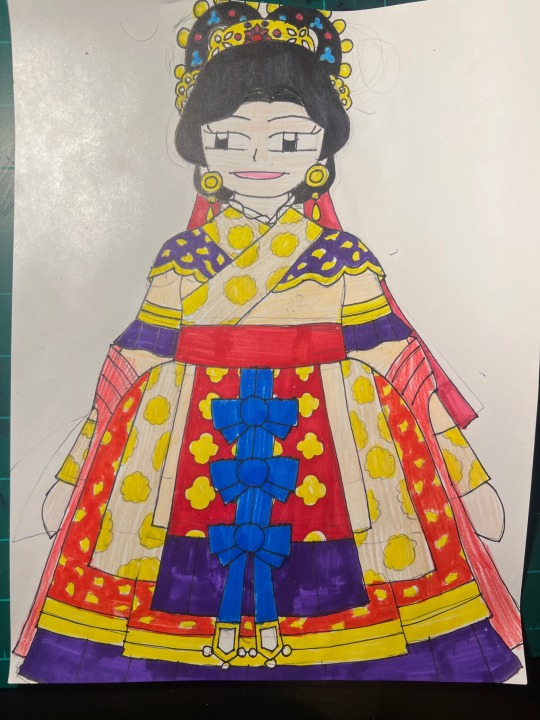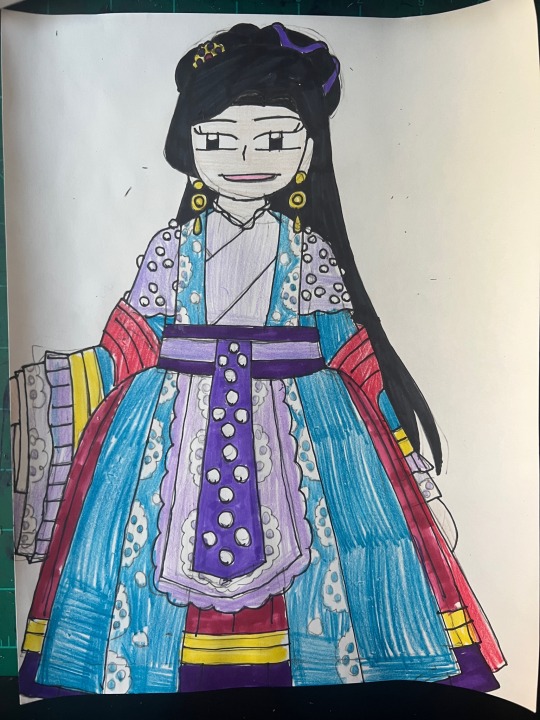#Royal Dyansties
Text

I drew a Korean Queen from the Joseon dynasty. She is wearing a Jangsam, a type of Hanbok worn by Royal women from the Early Joseon Dyansty. I hope you guys like it.
0 notes
Text
Translate and Transform
Hinduism - Art (LO1)
in Hinduism, there are four goals of life on earth - aim for dharma (righteous of living), artha (wealth aquired through the pursuit of profession), kama (human and sexual love) and moksha (spiritual salvation)
these holistic views are reflected in Hindu art
Hindu art encompasses a wide range of artistic traditions that spans for thousands of years
Hindu Temples
architecture and sculptures are linked to India
inside are beautiful, intricate decorations, sculptures and lighting
temples tend to be devoted to only one Hindu god or goddess
worshippers take off their shoes before entering and then ring a bell at the shrine to awaken the deity. They sing, chant and prayer and sometimes present offerings such as fruit, milk or money
symmetry driven structures with variations on square grids
the temples are built around the belief that everything is connected
typically in temples there are statues that display the four principles of life (artha, kama, dharma, moksha)
temples are designed to encourage reflection and facilitate the purification of ones mind


Ancient Period (up to the 6th Century)
earliest Hindu art can be found in the remains of the Indus Valley Civilisation in the Northern region of India - including seals depicting deities and symbols that are associated with early Hinduism


the Maurya and Gupta empires also had significant artistic development including sculpture and architecture


Medieval Period (7th - 18th century)
Hindu art flourished in various kingdoms and empires, each contributing to its unique style
the Chola dynasty in South India created bronze sculptures of Hindu deities

the Hoysala and Vijayanagara empires created temple complexes and sculptures with mythological beings and divine manifestations
The Hoysala empire (10-14th century) ruled India from 1006 - 1346 CE in South India (modern day Karnataka, India)
They were known for their temple architecture and intricate sculptures, with many inscriptions found in these temples providing valuable historical and cultural insights to the dyansties achievements
The Hoysala Empire declined due to internal conflict
Thee Vjayanagara Empire (14th-16th century) rose in the decline of the Hoysala kingdom
They were known for their political and military power
their architecture is characterised by temple complexes, royal enclosures and water management systems
they were the centre of art, culture and religion
the empire declined in the late 16th century
Both empires left behind a rich legacy of art, architecture and culture


Modern Period (19th Century onwards)
western influences and colonial rule led to significant changes in Hindu art
influenced the decline of traditional artistic practices and emerging of new European styles
The Bengal School of Art led the new movement, reviving traditional Indian art forms and techniques, inspired by classical Hindu texts and mythology


Key Characteristics
Polytheism
reflects the belief in a pantheon of gods and goddesses, each with their own attributes, roles and symbolism
the gods and goddesses are viewed as embodiments of the Divine Brahman
Iconography
deities often depicted with specific attributes (weapons, vehicles etc.) and symbols (lotus, conch shells etc.) that represent their attributes
Narratives
Hindu art often depicts narratives and stories from texts
serves as visual for religious teachings
Sacred Architecture
has very distinct architectural features
sacred space for worship and meditation with intricate sculptures, carvings and decoration
An Indian Modernist (Published 2008). (2024). The New York Times. [online] Available at: https://www.nytimes.com/slideshow/2008/08/20/arts/design/20080820_BOSE_SLIDESHOW_index.html [Accessed 6 Feb. 2024].
Artsy. (2016). Bengal School of Art | Artsy. [online] Available at: https://www.artsy.net/gene/bengal-school-of-art [Accessed 6 Feb. 2024].
Authors: Vidya Dehejia (2024). Hinduism and Hindu Art | Essay | The Metropolitan Museum of Art | Heilbrunn Timeline of Art History. [online] The Met’s Heilbrunn Timeline of Art History. Available at: https://www.metmuseum.org/toah/hd/hind/hd_hind.htm [Accessed 6 Feb. 2024].
Bbc.co.uk. (2024). Hindu worship in the temple - Practices - Eduqas - GCSE Religious Studies Revision - Eduqas - BBC Bitesize. [online] Available at: https://www.bbc.co.uk/bitesize/guides/zjmqmsg/revision/3 [Accessed 6 Feb. 2024].
Chola dynasty | Rulers & Time Period | Britannica. (2024). In: Encyclopædia Britannica. [online] Available at: https://www.britannica.com/topic/Chola-dynasty [Accessed 6 Feb. 2024].
Hoysala dynasty | Karnataka, South India, Temples | Britannica. (2024). In: Encyclopædia Britannica. [online] Available at: https://www.britannica.com/topic/Hoysala-dynasty [Accessed 6 Feb. 2024].
Khanacademy.org. (2023). Khan Academy. [online] Available at: https://www.khanacademy.org/humanities/whp-origins/era-3-cities-societies-and-empires-6000-bce-to-700-c-e/36-the-growth-of-empires-betaa/a/read-the-mauryan-and-gupta-empires-beta#:~:text=The%20Mauryan%20(322%2D185%20BCE,India's%20arts%20and%20sciences%20flourished. [Accessed 6 Feb. 2024].
Mark, J.J. (2020). Indus Valley Civilization. [online] World History Encyclopedia. Available at: https://www.worldhistory.org/Indus_Valley_Civilization/ [Accessed 6 Feb. 2024].
T Richard Blurton (1993). Hindu art. Cambridge Harvard University Press.
Vijayanagara.nic.in. (2020). History of Vijayanagara | Vijayanagara District Website | India. [online] Available at: https://vijayanagara.nic.in/history/ [Accessed 6 Feb. 2024].
0 notes
Photo

A significant and rare Henry VIII carved oak mount, 1533-6, of Anne Boleyn's (c.1501-36) royal badge, possibly by Richard Rydge.
Covered now in an off-black paint, with traces of a lighter pinkish bole below, and scattered areas of red pigment, and gilding, and modelled as a falcon wearing a closed imperial crown, its fore-wing furled over at the top, its rear wing aloft, and holding a sceptre formed as a pair of opposing balusters topped by a gadrooned ball knop, the falcon standing on a tapering stump or woodstock, pounced and with dentil-like protrusions, and issuing a spray of three rows of four flowers, on four curving stalks, 19.5cm wide x 3.5cm deep x 20.5cm high, (7 1/2in wide x 1in deep x 8in high)
Source/Read More
#anne boleyn#tudor era#tudor#tudor dyansty#royal badge#tudors#auction#history#OMFG LOOK AT THIS PEOPLE
139 notes
·
View notes
Text
It really bothers me how GRRM decided to make a theme of the "Targaryen madness" in his story because the more i read about Targaryen history the more i see they were just a, a royal family? With regular royal family dramas and crisis and fucks ups? (And yeah well dragons and stuff) but i mean no different from any other great dyansty. And really, MADNESS is a big word given that only like two of them could be labelled trully "mad". Yeah some of them have issues but "Targaryen madness" makes you think that schizophrenia ran in the family or sm
#asoiaf#a song of ice and fire#game of thrones#got#anti got#house targaryen#daenerys targaryen#house of the dragon#pro targaryen
57 notes
·
View notes
Text

I drew a Mongol Queen from the Goryeo Dyansty. She is wearing a Daesoosam, a type of Hanbok worn by Royal women from the Mid to late Goryeo. I hope you guys like it.
0 notes
Text

I drew a Korean Queen from the Goryeo Dynasty. She is wearing a Daesoosam, a type of Hanbok worn By Woman from the Royal family from the mid Goryeo to Late Goryeo Dyansty. I hope you guys like it.
0 notes
Text

I drew a Korean Princess from the Unified Silla Dynasty. I’m not sure the name of the Hanbok she wearing, but it looks like a mix between a Dangpung Yugun and Ungyeon, which were worn by Royal women in the Unified Silla and Balhae Dyansty to the early Goryeo Dyansty. I hope you guys like it.
0 notes